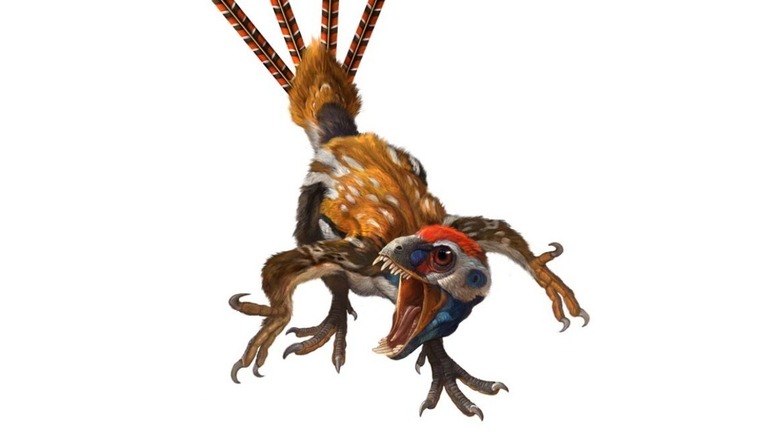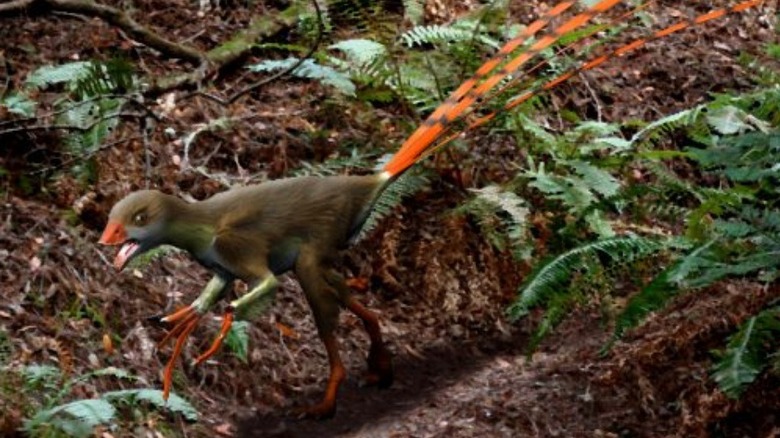One Of The Smallest Dinosaurs To Ever Exist Had An Unusual Feature
Big dinosaurs seem to get all the attention. Long-necked dinosaurs like Patagotitan, the largest animal to ever walk the earth, often dominate museum displays, relegating the smallest dinosaur fossils to tiny corner exhibits. But though they may be short in stature, small dinosaurs have fascinating stories to tell, too. One such creature is Epidexipteryx, whose fossil reveals a curious coat of furry feathers and long ribbon-like tail feathers.
Ever since the species was first identified, paleontologists have been puzzling over Epidexipteryx. Still, the nearly-complete fossil provided evidence of some irrefutable features. For one, Epidexipteryx was about the size of a pigeon, weighed less than 6 ounces, and walked on two legs. Furthermore, it's believed to have lived 168 to 152 million years ago, some time in the Jurassic Period. However, this time frame is curious; although it predates the earliest avian dinosaurs (the ancestors of birds), Epidexipteryx was covered in feathers. As paleontologist Zhonghe Zhou of the Chinese Academy of Sciences stated, "Although this dinosaur cannot be the direct ancestor for birds, it is one of the dinosaurs that have the closest phylogenetic relationship" (via Live Science).
Whatever Epidexipteryx used its feathers for, it wasn't flight. Most of its body feathers were fine enough to be mistaken for fur and probably served as insulation to keep the tiny dinosaur warm. Epidexipteryx also possessed four long tail feathers, though, unlike those of modern birds, they were composed of unbroken sheets, similar to a ribbon. They were most likely for display — either to attract mates, warn off competing males, or both. Yet, they may have served another purpose, as well. A few Epidexipteryx features suggest the animal was arboreal and employed its unusual tail feathers to aid in balance as it scurried along tree trunks.
Feathers for show, fingers for climbing
Paleontologists have known for a long time that dinosaurs had feathers, even if they still debate what exactly those feathers looked like. However, Epidexipteryx is the oldest known dinosaur to possess ornamental feathers. Discovered in 2008, scientists named it Epidexiptryx Hui, or "Hu's display feather," as a nod to both the renowned paleontologist Hu Yaoming and the species' striking tail feathers.
Though Epidexipteryx's feathers were strictly for show, the squirrel-sized dinosaur had a different trick for getting off the ground. Its front limbs supported long fingers that terminated in pointed claws which were used to climb trees. Epidexipteryx likely also used its long slender digits to poke into holes and burrows while searching for food. Whether those long fingers were also webbed with a membranous wing, however, is unlikely — but not impossible.
The 2008 Epidexipteryx fossil has no signs of membrane wings, but some of those of its close relatives do. Epidexipteryx is part of the dinosaur family scansoriopterygid, which means "climbing wing." Two species in the family, Yi qi and Ambopteryx, had membranous wings, similar to bat wings. This close taxonomic association of the three species, along with their shared feeding strategies and body plans, has led some eager observers to speculate that Epidexipteryx also possessed membranous wings, just like its relatives. Whether it did or not, such an adaptation would have been an evolutionary dead end towards true flight. A 2020 analysis published in iScience states it's "highly unlikely" the scansoriopterygid theropods had "any form of powered flight." At best, these creatures used the stretched skin between their fingers to glide from tree to tree, similar to flying squirrels.
All evidence points towards Epidexipteryx spending little to no time airborne, but, however it got around, it certainly looked fabulous doing so.

